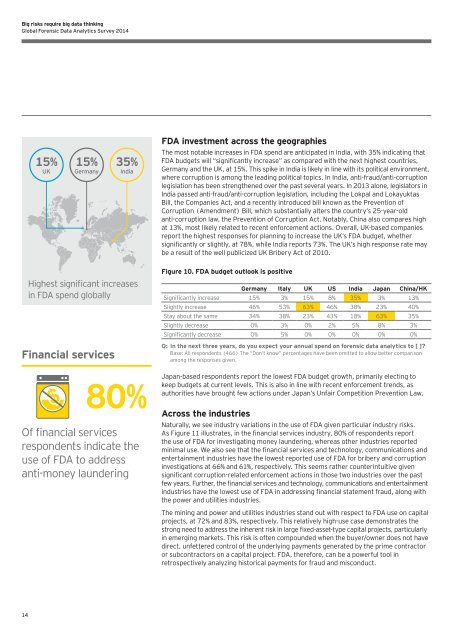EY-Global-Forensic-Data-Analytics-Survey-2014
EY-Global-Forensic-Data-Analytics-Survey-2014
EY-Global-Forensic-Data-Analytics-Survey-2014
Create successful ePaper yourself
Turn your PDF publications into a flip-book with our unique Google optimized e-Paper software.
Big risks require big data thinking<br />
<strong>Global</strong> <strong>Forensic</strong> <strong>Data</strong> <strong>Analytics</strong> <strong>Survey</strong> <strong>2014</strong><br />
FDA investment across the geographies<br />
15%<br />
UK<br />
15%<br />
Germany<br />
35%<br />
India<br />
The most notable increases in FDA spend are anticipated in India, with 35% indicating that<br />
FDA budgets will “significantly increase” as compared with the next highest countries,<br />
Germany and the UK, at 15%. This spike in India is likely in line with its political environment,<br />
where corruption is among the leading political topics. In India, anti-fraud/anti-corruption<br />
legislation has been strengthened over the past several years. In 2013 alone, legislators in<br />
India passed anti-fraud/anti-corruption legislation, including the Lokpal and Lokayuktas<br />
Bill, the Companies Act, and a recently introduced bill known as the Prevention of<br />
Corruption (Amendment) Bill, which substantially alters the country’s 25-year-old<br />
anti-corruption law, the Prevention of Corruption Act. Notably, China also compares high<br />
at 13%, most likely related to recent enforcement actions. Overall, UK-based companies<br />
report the highest responses for planning to increase the UK’s FDA budget, whether<br />
significantly or slightly, at 78%, while India reports 73%. The UK’s high response rate may<br />
be a result of the well publicized UK Bribery Act of 2010.<br />
Highest significant increases<br />
in FDA spend globally<br />
Financial services<br />
80%<br />
Of financial services<br />
respondents indicate the<br />
use of FDA to address<br />
anti-money laundering<br />
Figure 10. FDA budget outlook is positive<br />
Germany Italy UK US India Japan China/HK<br />
Significantly increase 15% 3% 15% 8% 35% 3% 13%<br />
Slightly increase 46% 53% 63% 46% 38% 23% 40%<br />
Stay about the same 34% 38% 23% 43% 18% 63% 35%<br />
Slightly decrease 0% 3% 0% 2% 5% 8% 3%<br />
Significantly decrease 0% 5% 0% 0% 0% 0% 0%<br />
Q: In the next three years, do you expect your annual spend on forensic data analytics to [ ]?<br />
Base: All respondents (466) The “Don’t know” percentages have been omitted to allow better comparison<br />
among the responses given.<br />
Japan-based respondents report the lowest FDA budget growth, primarily electing to<br />
keep budgets at current levels. This is also in line with recent enforcement trends, as<br />
authorities have brought few actions under Japan’s Unfair Competition Prevention Law.<br />
Across the industries<br />
Naturally, we see industry variations in the use of FDA given particular industry risks.<br />
As Figure 11 illustrates, in the financial services industry, 80% of respondents report<br />
the use of FDA for investigating money laundering, whereas other industries reported<br />
minimal use. We also see that the financial services and technology, communications and<br />
entertainment industries have the lowest reported use of FDA for bribery and corruption<br />
investigations at 66% and 61%, respectively. This seems rather counterintuitive given<br />
significant corruption-related enforcement actions in those two industries over the past<br />
few years. Further, the financial services and technology, communications and entertainment<br />
industries have the lowest use of FDA in addressing financial statement fraud, along with<br />
the power and utilities industries.<br />
The mining and power and utilities industries stand out with respect to FDA use on capital<br />
projects, at 72% and 83%, respectively. This relatively high-use case demonstrates the<br />
strong need to address the inherent risk in large fixed-asset-type capital projects, particularly<br />
in emerging markets. This risk is often compounded when the buyer/owner does not have<br />
direct, unfettered control of the underlying payments generated by the prime contractor<br />
or subcontractors on a capital project. FDA, therefore, can be a powerful tool in<br />
retrospectively analyzing historical payments for fraud and misconduct.<br />
14


